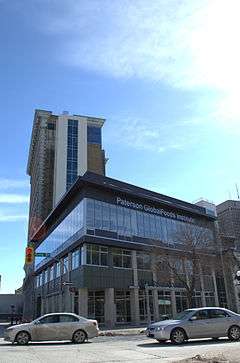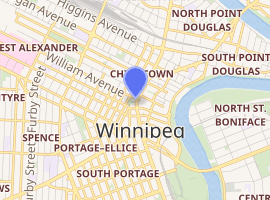Union Bank Building
The Union Bank Building is located in the Exchange District of Winnipeg, Manitoba, once forming the northern end of Main Street's prestigious Banker's Row.[1] The 10-storey (plus mezzanine) building began construction in 1903, opening in November 1904, towering over its neighbours at a height of 47.58 meters (156').[2].
| Union Bank Building | |
|---|---|
 | |

| |
| Alternative names | Former Union Bank Building, Paterson Globalfoods Institute |
| General information | |
| Architectural style | Classical palazzo |
| Location | Exchange District, Winnipeg, Manitoba |
| Address | 500-504 Main Street |
| Town or city | Winnipeg |
| Country | Canada |
| Coordinates | 49.8988°N 97.1394°W |
| Current tenants | Red River College's Paterson Globalfoods Institute |
| Construction started | 1903 |
| Completed | 1904 |
| Opened | November 1904 |
| Renovated | 2013 |
| Cost | $420,000 |
| Renovation cost | $34 million |
| Height | |
| Architectural | 47.58 meters (156') |
| Technical details | |
| Floor count | 10 (plus mezzanine) |
| Design and construction | |
| Architecture firm | Pearson and Darling |
| Main contractor | Fuller Construction Company |
| Designations | |
| Official name | Former Union Bank Building / Annex National Historic Site of Canada |
| Designated | 1996 |
| References | |
| Canada's Historic Places | |
The Union Bank Tower was the tallest building in Winnipeg at its completion, with its ten stories beating the newly built Merchants' Bank building's eight stories.[3] Union Bank Tower is the oldest surviving of Canada's tallest buildings to incorporate a steel skeleton structure that fully supports a light-weight, veneer 'curtain wall' facade, the design innovation that facilitated the proliferation of skyscrapers in the 20th century. Winnipeg's now demolished Merchant Bank Building proceeded it by several years in use of steel structure construction. [4] At the time of opening, the top floor of Union Bank was the second-highest in the British Empire, one metre below London’s tallest building. It had the largest and fastest elevator in Western Canada and was the first building in Canada to introduce the modern concept of a general contractor to oversee construction. Initially built for Union Bank, it remained vacant for 18 years starting in the late 1990s, until it was redeveloped into the Paterson Global Foods Institute and student housing for Red River College in 2013.[5][6] It was designated a National Historic Site of Canada in 1996.[7]
Construction

The Union Bank Tower is an example of the Chicago Style.[1] Using technology that was cutting edge for its time, the building was constructed with a network of steel and reinforced concrete that provided support for the brick and terracotta walls.[8] The previously common building support system was that of wooden beams and posts or masonry. The tower's steel framing increased the overall rigidity and fire resistance of the structure compared to its predecessors.[8]
At the time of its original construction, the building rose to 47.58 metres (156.1 ft) above grade, running 18.30 metres (60.0 ft) on Main Street, 33.55 metres (110.1 ft) along William Avenue, 24.71 metres (81.1 ft) at the rear, and 34.16 metres (112.1 ft) on its south side.[8] The design of the building is based on a classical column. The bottom two storeys form the base and are highly ornamented. The middle storeys form the body of the column and are less ornamented, and the upper level have similar embellishment to the ground floor.[9] At the time of construction, the ground floor was to be used entirely as a banking room, with the rest of the building divided into suites of offices, each with its own vault, telephone box, and lavatory, and the building was to have three elevators.[10]
Designed by two of Canada’s top architects, Frank Darling and John Andrew Pearson,[11] initial construction of the building cost $420,000 and it was built by two New York City construction firms: George A. Fuller Company and Thompson and Starret and Company.[8] The frame of riveted interlocking girders was manufactured by Dominion Bridge of Montreal, and the ochre brick came from the Lac du Bonnet brickworks.[8]
Occupancy
The Royal Bank of Canada took over the Union Bank in 1925 and operated out of the Union Bank Building until 1992.[5] In 1992, the Royal Bank moved out of the building and to a new location at James Avenue and Main Street.[12]
The building sat vacant for 18 years before being renovated, repurposed and opened as the Paterson Globalfoods Institute of Red River College in 2013.[6][12]
Paterson Globalfoods Institute
In May 2009, the Government of Canada pledged Red River College with $9.5-million of funding to help reconstruct the Union Bank Building at the corner of Main Street and William Avenue in downtown Winnipeg to house the new Paterson Globalfoods Institute. The Manitoba government also announced a contribution of $5-million towards the construction of the building.[13][14] The project was developed by Red River College, with additional project partners including: Paterson GlobalFoods Inc., Centre Venture, City of Winnipeg, Province of Manitoba, Government of Canada, and Prairie Architects.[15] Both the exterior as well as a significant amount of the interior of the Tower (including the main floor banking hall) were fully restored as part of the renovation.[15]
The Paterson Globalfoods Institute is an addition to Red River College's Exchange District Campus that was completed in January 2013.[6] The institute is the new home of the Culinary Arts, Hospitality and Tourism Management and Professional Baking and Patisserie programs.[16]
The new 100,000-square-foot (9,300 m2)[17] institute provides classroom and kitchen space and two restaurants on the first three floors, a rooftop patio and garden,[18] as well as residence for 103 students on the floors above.[19][20] The housing units are available in one or two bedroom configurations.[15] The renovation is expected to cost $34 million, up from the initial $27 million estimate,[19] and involved the addition of two new glass fronted structures adjacent to the existing Union Bank Tower.[20] The new adjacent structures were required for the project because the tower itself could not house the necessary heating and cooling systems.[21] The adjacent structure is located on the lot formerly occupied by the Leland Hotel which burned down in 1999.[22]
Jane's Restaurant is an 80-seat fine dining restaurant located in the renovated main banking hall.[6][23] The building also features a 94-seat casual cafe called the "Culinary Exchange", and "Grab-and-Go", a quick service food outlet.[24]
References
| Wikimedia Commons has media related to Union Bank Building (Winnipeg). |
- "504 MAIN STREET – ROYAL TOWER (FORMERLY UNION TOWER)" (PDF). City of Winnipeg Historical Buildings Committee. June 1993. p. 2. Retrieved 14 September 2012.
- "504 MAIN STREET – ROYAL TOWER (FORMERLY UNION TOWER)" (PDF). City of Winnipeg Historical Buildings Committee. June 1993. p. 9. Retrieved 14 September 2012.
- "Union Bank to Build a Skyscraper". Winnipeg Tribune. 1903-05-23. Retrieved 2020-07-25.
- url=http://riseandsprawl.blogspot.com/2007/09/western-canadas-first-skyscraper.html
- "Century-old Winnipeg skyscraper getting $27M makeover". CBC News. 20 May 2009. Retrieved 14 September 2012.
- Martin, Nick (10 January 2013). "Red River College's culinary institute open for classes". Winnipeg Free Press. Retrieved 10 January 2013.
- [http://www.historicplaces.ca/en/rep-reg/place-lieu.aspx?id=1136&pid=0 Former Union Bank Building / Annex National Historic Site of Canada ]. Canadian Register of Historic Places. Retrieved 14 September 2012.
- "504 MAIN STREET – ROYAL TOWER (FORMERLY UNION TOWER)" (PDF). City of Winnipeg Historical Buildings Committee. June 1993. p. 3. Retrieved 14 September 2012.
- "504 MAIN STREET – ROYAL TOWER (FORMERLY UNION TOWER)" (PDF). City of Winnipeg Historical Buildings Committee. June 1993. p. 4. Retrieved 14 September 2012.
- "Pulse of Trade in the Metropolis". Winnipeg Tribune. 1904-07-27. Retrieved 2020-07-25.
- "504 MAIN STREET – ROYAL TOWER (FORMERLY UNION TOWER)" (PDF). City of Winnipeg Historical Buildings Committee. June 1993. p. 7. Retrieved 14 September 2012.
- Dudgeon, Robin (25 November 2010). "Building on the past to create the future". The Uniter. Retrieved 10 January 2013.
- Kives, Bartley (20 May 2009). "Red River College gets help to renovate Union Bank Tower". Winnipeg Free Press. Retrieved 3 August 2012.
- "Cash for inner-city campuses". Winnipeg Free Press. 21 May 2009. Retrieved 3 August 2012.
- "Paterson GlobalFoods Institute at Red River College". SpeakUpWinnipeg. Retrieved 15 September 2012.
- "A Peek Inside Paterson GlobalFoods Institute at RRC". Red River College. Retrieved 12 September 2012.
- "Paterson Global Foods Institute". Affinity Firestop Consultants. Retrieved 12 September 2012.
- "Paterson GlobalFoods Institute Poised to Revitalize Exchange District". Red River College. 27 April 2012. Retrieved 4 October 2012.
- McNabb, Lauren (27 April 2012). "Breathing new life into historic Exchange District building". Global Winnipeg. Retrieved 12 September 2012.
- "Paterson GlobalFoods Announces The Paterson Globalfoods Institute". Paterson Globalfoods Inc. Archived from the original on 31 January 2013. Retrieved 12 September 2012.
- Kives, Bartley (16 October 2009). "Heritage reborn". Winnipeg Free Press. Retrieved 14 September 2012.
- "Asterisk". Assiniboine Credit Union. June 2011. p. 8. Retrieved 4 October 2012.
- "Red News". Red River College. January 2011. Retrieved 4 October 2012.
- "RRC Begins Construction on the Paterson GlobalFoods Institute". Red River College. 15 October 2009. Retrieved 4 October 2012.